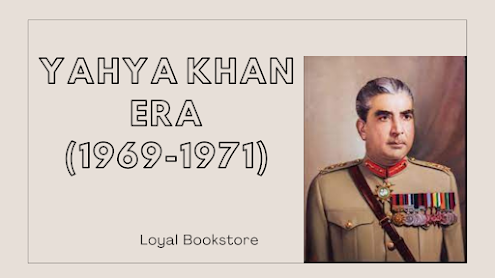Agha Mohammad Yahya Khan Era (1969-1971)
Ayub Khan had proclaimed a heavy and long term agenda of economic development at the time of assuming power. Yahya Khan made no such high claims. He assumed power on March 25, 1969 and assured the nation that his only agenda was to hold elections and to hand over power to the elected representatives of the people as soon as possible. He kept his pledge. The election conducted by him were the most fair and free elections of the country’s history.

The Legal Framework Order (LFO): On March 30, 1970 Yahya Khan issued a Legal Framework Order. The LFO stipulated basic roadmap for election and transfer of power i.e.
The National Assembly will consist of 313 members. Three hundred seats will be filled through general election, 13 seats will be reserved for women. On the basis of population the East Pakistan was given 169 (162 general and 7 women), and the West Pakistan was given 144 (138 general and 6 women) seats. Number of Provincial Assemblies seats was also specified. The National Assembly was mandated to frame constitution within 120 days.
Yahya Khan appointed the new Election Commissioner on July 28, 1970. All the princely states, that up till that time were enjoying a special status, were annexed with Pakistan. The province of West Pakistan was dissolved and the four provinces were revived. The democratic principle of one-man-one-vote was upheld. East Pakistan politicians welcomed the LFO because East Pakistan’s population was larger than the total population of the four West Pakistan provinces and the LFO promised representation on the basis of population.
Elections 1970
Elections under the LFO were held in December 1970 on the basis of adult franchise. The elections were transparent and free, but unfortunately the election results proved fatal for the solidarity of Pakistan. The Awami League could not get even a single seat in the west wing; on the other hand, it captured 160 out of 162 general seats in East Pakistan. The secret of Awami Leagues landslide victory was its 6 points programme which was based in provincialism. In two out of the four West Pakistan provinces (The Punjab and Sind) Pakistan People Party emerged as the single majority party but in East Pakistan it was not able to put up even a single candidate. In West Pakistan the People’s Party had absolute majority. The four provinces of West Pakistan had 138 general seats in the National Assembly; Pakistan People Party won 81 out of this number.
Separation of the East Pakistan
The biggest parties of East Pakistan and West Pakistan, the Awami League and the Pakistan People’s Party respectively, could not agree on any formula for the formation of government. On the other hand, in August 1971, by signing a military pact with the Soviet Union the Indians strengthened their position and gained the power they required for the breaking of Pakistan. In November 1971 the Indian forces crossed the international borders and entered East Pakistan.
Mukti Bahini, the terrorist wing of the Awami League started attacking the positions of Pakistan army and providing support to Indian Army. Border skirmishes gradually developed into a full scale war. India opened new fronts on West Pakistan borders.
The Pakistan army was cut into two parts, its position in East Pakistan was even more miserable; it was to fight on two fronts, the local rebels on one side and the Indian Army on the other On December 16, 1971 Indian troops entered Dacca and the Pakistan Army had to surrender. More than 90 thousand Pakistani soldiers and officers were taken prisoner and transferred to Indian camps. Bangladesh was officially proclaimed a republic on December 21, 1971.
